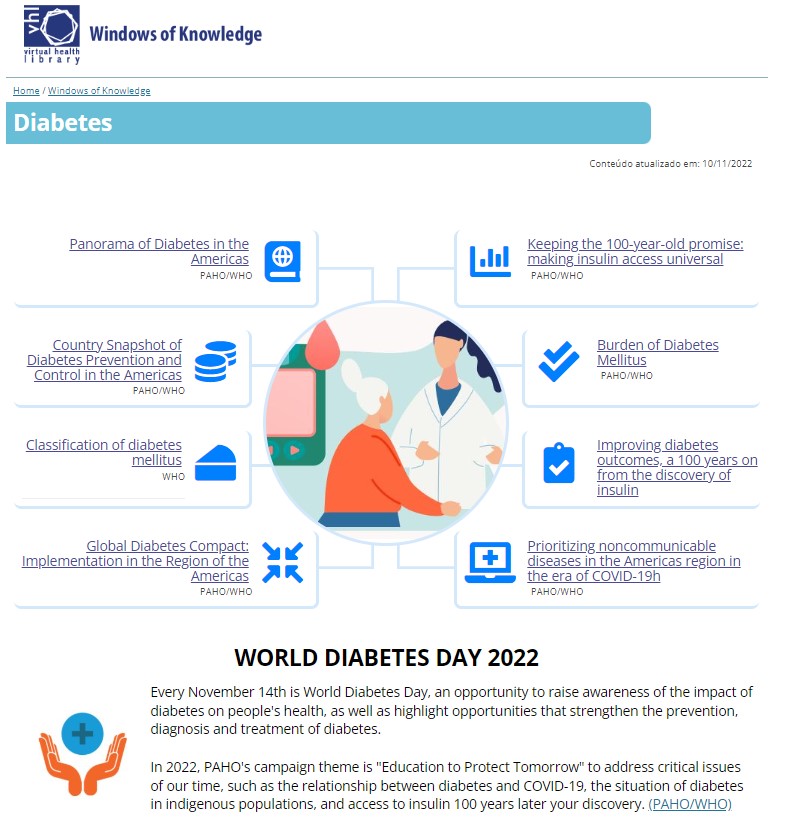November 14th marks World Diabetes Day, celebrating the birth date of Sir Frederick Banting, the co-discoverer of insulin[1] in 1922. The worldwide celebration is an opportunity to raise awareness about the impact of diabetes. in people’s health and highlight the opportunities that exist to strengthen the prevention, diagnosis, and treatment of diabetes.
This year’s theme is “Education to Protect Tomorrow”. PAHO calls for the need to strengthen access to quality diabetes education for both the health team and people living with diabetes, their caregivers, and society in general.
The number of people living with diabetes in the world has increased from 108 million to 420 million in the last thirty years; 62 of these million are in the Region of the Americas. This number has more than tripled in the Region since 1980 and could be even higher, since 40% of people with diabetes are unaware of their condition.
The expansive increase in the diabetes epidemic goes hand in hand with the increase in its risk factors. The Americas is the region with the most overweight/obesity and physical inactivity in the world: 63 out of 100 adults are overweight or obese and 39 out of 100 people have an insufficient level of physical activity.
The PAHO publication Panorama of Diabetes in the Americas (available in English) integrates data from various sources on key indicators for the Region, including diabetes mortality, its prevalence, and national responses to the disease. It also addresses critical problems of our time, such as the relationship between diabetes and COVID-19, the situation of diabetes in indigenous populations, and access to insulin in countries one hundred years after its discovery.
To celebrate the launch of the publication, PAHO organized the Web Seminar “World Diabetes Day 2022” on November 11, with specialists in noncommunicable diseases from the Organization, the Ministries of Health of the Member Countries, and other institutions. involved. The recording of the webinar is available on the PAHO YouTube Channel with simultaneous interpretation in Spanish, whose program is available (in Spanish and English).
Window of Knowledge
The Diabetes Window of Knowledge includes information on diabetes for health professionals, researchers, decision makers, students pursuing careers in health, and the general public. This information source organized by BIREME/PAHO/WHO is periodically updated with documents, scientific articles, publications from international organizations and scientific societies on this noncommunicable disease that affects millions of people in the Region of the Americas.
 Especially in relation to type 2 diabetes, awareness that leads to prevention and care such as healthy eating and physical activity, associated with blood glucose measurements, can prevent disabilities and premature deaths in most cases.
Especially in relation to type 2 diabetes, awareness that leads to prevention and care such as healthy eating and physical activity, associated with blood glucose measurements, can prevent disabilities and premature deaths in most cases.
Links of interest
Diabetes – PAHO Health Topics – https://www.paho.org/en/topics/diabetes
Diabetes – PAHO/WHO Health Topics – https://www.who.int/news-room/fact-sheets/detail/diabetes
International Diabetes Federation – https://www.idf.org/
World Diabetes Day Webinar – https://www.paho.org/en/events/event-world-diabetes-day-2022.
PAHO TV: https://www.youtube.com/watch?v=mHzCTSC4ibU&t=16s
Pan American Health Organization. Panorama of Diabetes in the Americas. Washington, D.C.: OPS; 2022. https://doi.org/10.37774/9789275126332 (in English)
Pan American Health Organization. Global Diabetes Compact: Implementation in the Region of the Americas. https://www.paho.org/en/topics/diabetes/global-diabetes-compact-implementation-region-americas
Pan American Health Organization. Essential Medicines for Noncommunicable Diseases Available through the PAHO Strategic Fund. https://iris.paho.org/handle/10665.2/55092
BIREME/PAHO/WHO. Diabetes Window of Knowledge. https://bvsalud.org/vitrinas/en/post_vitrines/diabetes/
[1] Diabetes is the body’s inability to properly metabolize sugar. Doctors realized that diabetes is caused by a lack of insulin, which is made in parts of the pancreas, but they could not prove it. Frederick Banting suspected that another substance formed in the pancreas, trypsin, broke down insulin. In John MacLeod’s laboratory in 1921, Frederick Banting and Charles Best treated dogs so that they no longer produced trypsin. The insulin could then be extracted and used to treat diabetes. In 1923 John MacLeod and Frederick Banting were awarded the Nobel Prize in Physiology or Medicine. Charles Best, who did not receive his medical degree until 1925, did not share the Nobel Prize with Banting and MacLeod. One of these injustices in history.
Source: (except for Charles Best) Frederick G. Banting – Facts. NobelPrize.org. https://www.nobelprize.org/prizes/medicine/1923/banting/facts/